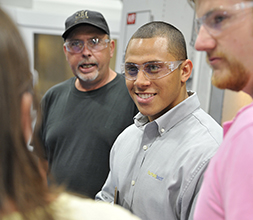How to Motivate Ergonomics Team Members
05/16/2017

Getting your ergonomics team members to do their best work can be challenging. Employee motivation  and human performance have been studied for centuries. Nohria, Groysberg, and Lee (2008) have narrowed this enormous body of research down to four basic emotional needs or primary drivers that motivate employees; as set out by Paul Lawrence and Nitin Nohria in their 2002 book Driven: How Human Nature Shapes Our Choices, they are the following:
and human performance have been studied for centuries. Nohria, Groysberg, and Lee (2008) have narrowed this enormous body of research down to four basic emotional needs or primary drivers that motivate employees; as set out by Paul Lawrence and Nitin Nohria in their 2002 book Driven: How Human Nature Shapes Our Choices, they are the following:
- Acquire – the drive to obtain scarce goods or intangibles, like social status
- Bond – the desire to form connections with individuals and groups
- Comprehend – the need to satisfy our curiosity and master the world around us
- Defend – the drive to promote justice
Effective managers know that a motivated workforce achieves a better team performance. But how can you use these principles and what actions can you take to motivate your ergonomics team members? Although all four emotional drivers are essential for success, the research suggests that each has its own distinct lever or trigger.
Satisfy the desire to acquire through a rewards system or recognition program that acknowledges employees who achieve certain goals. Identify markers for good performance and poor performance, and establish goals that link to specific rewards. For ergonomics team members, goals could be centered on activity metrics, for example, completing a certain number of job assessments. Or, performance goals could be based on risk reduction metrics, like reducing quantitative baseline analyses by a certain percentage.
Establish a culture that promotes teamwork, collaboration, openness, and friendship to address the desire to bond. Create opportunities for ergonomics team members to build strong connections within their teams. Invite operators to join brainstorming sessions to get their first-hand knowledge and promote collaboration and openness. When possible, have ergonomics team members work alongside operators on the production floor to build trust and promote teamwork.
To address the drive to comprehend, design jobs that are meaningful, interesting, and challenging; work tasks should be achievable, but also continuously challenging for ergonomics team members. Educate them about the impact their work has on the organization’s broader goals. Create opportunities for continuous growth and development by exposing them to advanced training programs, conferences, and analysis tools.
To fulfill the desire to defend, increase transparency in the decision-making process and emphasize fairness as a way of building trust. Allow ergonomics team members to present their analyses and recommendations to management for a fair and transparent review. Ensure that management provides clear, unfiltered explanations for any decisions that affect the ergonomics team, their activities, or their recommendations for improvement.
Try a new approach to motivating the workforce by fulfilling your ergonomics team members’ fundamental needs. You may be surprised at the boost in overall performance.
Citations:
Lawrence, P.R., and Nohria, N. Driven: How Human Nature Shapes Our Choices. San Francisco: Jossey-Bass, 2001.
Nohria, N., Groysberg, B., and Lee, L. Employee Motivation: A Powerful New Model. HBS Centennial Issue Harvard Business Review 86, nos. 7/8 (July–August 2008): 78–84.






